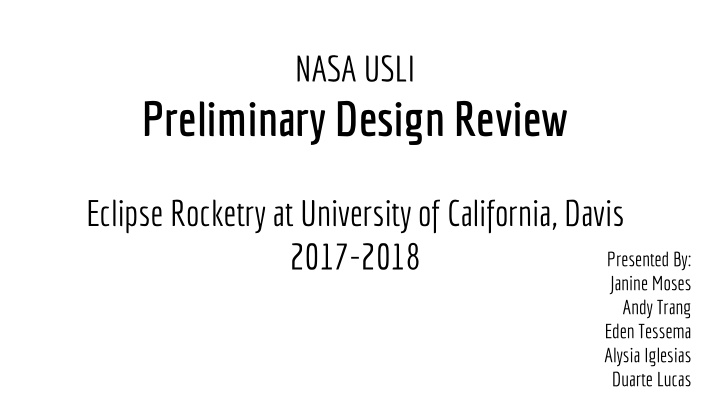



NASA USLI Preliminary Design Review Eclipse Rocketry at University of California, Davis 2017-2018 Presented By: Janine Moses Andy Trang Eden Tessema Alysia Iglesias Duarte Lucas
OVERVIEW School Information ● Vehicle Summary and Mass Budget ● Vehicle Design - In Depth ● Motor Selection ● Payload Design - In Depth ● Verification Plan and Testing ● Mission Performance and Predictions ● Compliance Matrix ●
SCHOOL INFORMATION Name of school/organization: UC Davis – Eclipse Rocketry Team ● Mailing Address: ● Attn: Nesrin Sarigul-Klijn Professor and Director of SpaceED Mechanical and Aerospace Engineering Department 2132 Bainer Drive Davis, CA 95616-5294 Reusable Rocket Vehicle Proposed: “Ballistic Bovine” ● Team Faculty Advisor: Dr. Nesrin Sarigul-Klijn ● Launch Assistance/Mentor: ● Cliff Sojourner - 82864 408.234.9281
VEHICLE SUMMARY
VEHICLE SUMMARY Length: 98’’ Diameter (excluding camera fairings) : 6.142’’ Motor: Aerotech L1150-P Total Mass (with motor): 29.38 lbs Material: G10 Fiberglass Airframe, plywood bulkheads, other electronic parts Payload: Target Acquisition, Recognition, and Processing System (TARPS)
COMPONENT LAYOUT
VEHICLE BASICS C.G: 65.381” from nose C.P: 77.87” from nose Static Stability Margin, Dry Mass: 3.34 caliber Static Stability Margin, with Motor: 2.03 caliber
VEHICLE BASICS Thrust to Weight Ratio: 8.78 Rail Exit Velocity: 67.1 ft/s
Mass Breakdown Component Weight (lb.) Component Weight (lb) Nose Cone 4.01 Payload Experiment 2.5 Airframe 1 1.59 Airframe 3 7.04 Main Parachute Motor 0.8375 8.13 Avionics Bay 1.175 Static Fins 2.5 Airframe 2 2.06 Total Dry Mass (no motor) 21.23 Drogue Chute 0.313 Total Mass with Motor 29.36
Vehicle Structure
Vehicle Structures External Structures ● Fuselage: Nose cone, Fins, Airframe ○ Internal Structures ● Bulkheads ○ Couplers ○ Material choice ● G10 - Fiberglass ○ Phenolic ○ Manufacturer ● Public Missiles Ltd. ○
Vehicle Payload Integration Attachment between Airframes 2 and ● 3 during flight. Payload bay coupler will be epoxied ● and bolted to airframe 3 (purple) and attached to airframe 2 (green) with shear pins. Must withstand drogue parachute ● deployment from black powder charges as well as rocket launch vibrations/flight loads.
Recovery System Dual Deployment ● Drogue: Fruity Chutes Classic Elliptical 18" Standard Parachute ○ Main: Fruity Chutes Iris Ultra 84" Compact Parachute ○ Ejection Method: Blackpowder with electronic igniter ● Altimeter: Perfectflite Stratologger ● Tracking Device: ArduPilot MEga 2.6 GPS ● www.fruitychutes.com
Recovery System Altimeter ● Barometric testing ○ Ejection charges ● Shear pins ○ Black powder mass ○ Tracking system ● Distance and location testing and verification ○
MOTOR SELECTION AND PROPULSION SYSTEM
Motor Selection Must propel rocket to at least ● 5280 ft AGL. Aerotech ● L1150-P ○ Motor-thrust curve from ● ThustCurve.org Average Thrust: 258.1 lbf ● Total Impulse: 790.65 lbf-s ●
Motor Specifics Diameter 2.95 inches Length 20.9 inches Propellant Mass 4.58 lbs Total Mass 8.125 lbs Average Thrust 258.1 lbf Peak Thrust 294.5 Ib Total Impulse 784.4 Ib*s Rail Exit Velocity 67.1 ft/s Thrust-to-Weight Ratio 8.78 Thrust Duration 3.04 s
Mission Performance and Predictions
Altitude and Velocity
Drift & Kinetic Energy Tailwind (miles/hr) Lateral Drift (ft) Kinetic Energy (ft*lbf) 0 163.83 43.39 5 594.72 42.45 10 860.03 38.82 15 1318.9 39.33 20 1748.6 39.07
Target Acquisition, Recognition, and Processing System (TARPS) Payload
Payload: Target Acquisition, Recognition, and Processing System (TARPS) Overview Requirements ● USLI ○ Self-derived ○ Structure ● Camera fairings ○ Image ● Processing System
Payload: Target Acquisition, Recognition, and Processing System (TARPS) Hardware ● Camera ○ Microprocessor and Sensors ○ Power source ○
Payload: Target Acquisition, Recognition, and Processing System (TARPS) Software ● Image processing ○ Automation ○ Data verification (tarp color ○ differentiation)
Verification Plan and Test Plan Overview
Compliance Matrix Requirement Completed Design Feature Requirement Rocket must reach apogee of 5280 ft. AGL, and Yes Rocket motor choice cannot exceed 5600 ft. AGL Rocket must be recoverable and reusable Yes Recovery system/Vehicle Design Rocket can only use commercial, NAR/TRA certified Yes Motor choice solid motor propulsion system Rocket motor cannot exceed total impulse of 5120 Ns Yes Motor choice Includes Payload Yes Payload design
Requirement Completed Design Feature Requirement Deployment of recovery devices must be staged. Dual Yes Recovery system deployment must be used. Each independent section must land with a maximum Yes Recovery system/Overall rocket Kinetic Energy of 75ft*lbf design Only Electronic recovery system must be completely Yes Recovery System independent of payload circuits Drogue and main parachutes must be deployed with Yes Recovery System removable shear pins Rocket and payload can only cost a maximum of $7500 Yes Overall rocket design and as it sits on launch pad. component choice
Thank You!
Recommend
More recommend